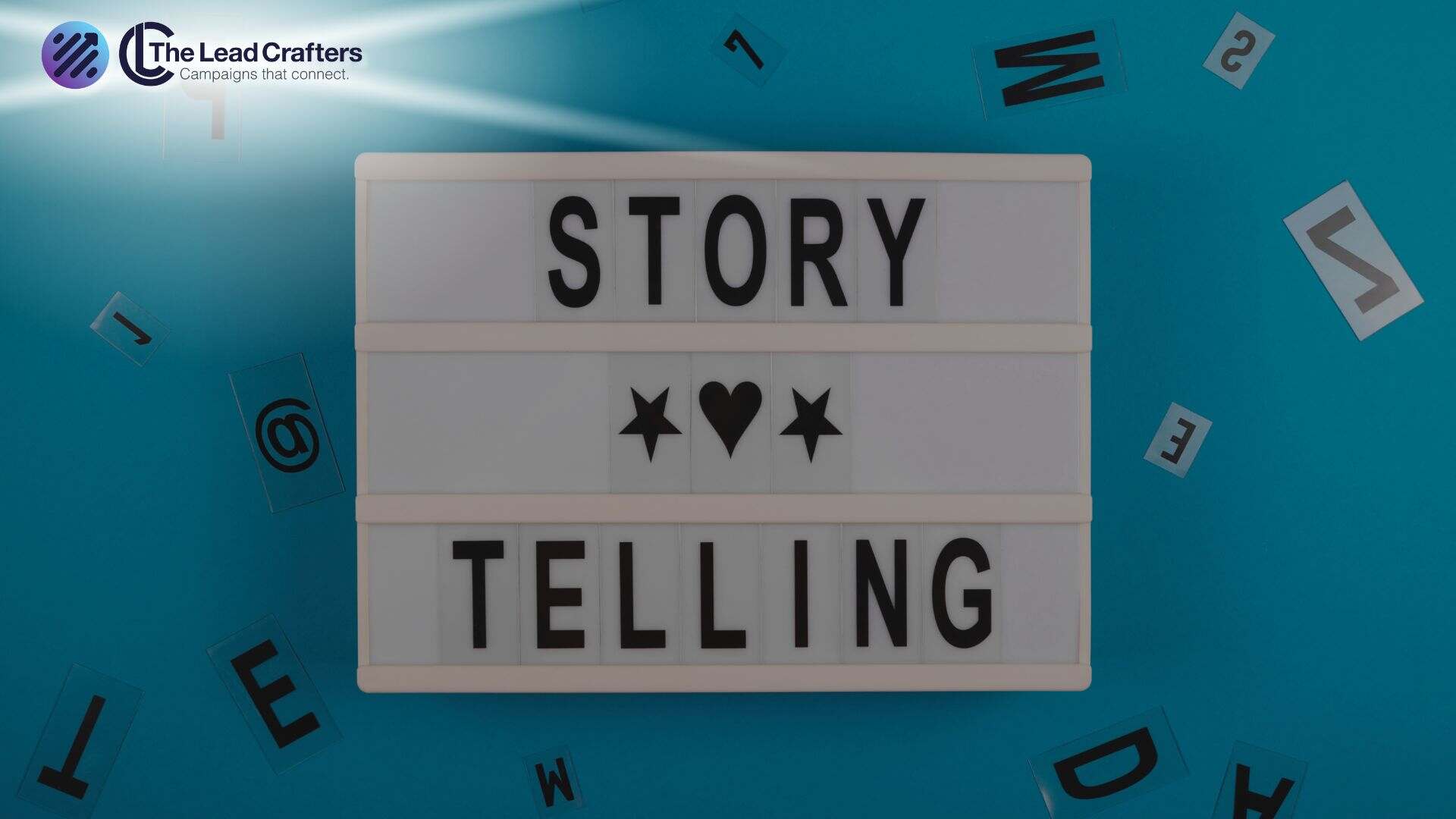In today’s saturated market, capturing your audience’s attention isn’t enough you need to resonate with them. Storytelling has emerged as the secret weapon in demand generation campaigns, helping brands connect emotionally, build trust, and guide prospects toward action. At The LeadCrafters, we believe the right narrative can transform passive awareness into active demand.
In this blog, we’ll explore:
- What demand generation truly is and how it differs from lead generation.
- Why storytelling matters in creating effective demand gen campaigns.
- Proven tactics to weave narrative into content and demand channels.
- Real-world examples showcasing storytelling in action.
- Actionable tips to elevate your demand generation strategy with storytelling.
What is Demand Generation and How Does Storytelling Elevate It?
The goal of demand creation, a comprehensive marketing strategy, is to raise interest in and awareness of your goods and services throughout the purchasing process. Unlike lead generation which zeroes in on capturing contact info demand gen casts a wider net: it encompasses brand awareness, consideration, and nurturing until prospects are ready to convert.
Storytelling enriches demand gen by:
- Humanizing the brand: Stories connect emotionally; people connect with people, not faceless brands.
- Creating memorable experiences: Narratives stick longer and are more shareable than facts.
- Simplifying complex ideas: A story can make even technical offerings relatable and easy to understand.
- Guiding emotional engagement: Through story arcs, you can empathize with pain points and position your solution as the hero.
Why Storytelling Works in Demand Generation
1. Emotional Connection Drives Action
Neuroscience tells us that emotional engagement (rather than logic alone) significantly influences decision-making. When prospects see themselves in your narrative addressing a shared pain, ambition, or journey they’re more likely to engage downstream.
2. Differentiation in a Competitive Landscape
Your competitors may sell similar features but your story is yours alone. A carefully crafted narrative highlights your unique approach, values, or outcomes, helping you stand out in a crowded market.
3. Builds Trust Over Time
Trust isn’t built in an instant; it’s earned through consistent storytelling that aligns with your audience’s needs and aspirations. Sharing stories of real customer experiences, challenges overcome, or brand ethos fosters credibility.
4. Content Becomes More Shareable
Audiences share content that moves them stories that inspire, entertain, or educate. When your demand generation assets carry narrative threads, they’re more likely to get shared, extending your reach naturally.
Storytelling Tactics for Demand Generation Success
Let’s explore how to embed storytelling into each stage of your demand generation funnel:
1. Awareness Phase: Set the Scene
- Use hero’s journey storytelling – Frame your audience as the hero, navigating challenges. Your brand or solution plays the wise guide.
- Share relatable scenarios – Use real-life vignettes: “Meet Sarah, a marketing manager overwhelmed by fragmented data…” Draw your audience in through familiar situations.
- Employ narrative hooks – Open with a provocative question, dramatic statement, or conflict to immediately capture attention.
2. Consideration Phase: Introduce Depth
- Tell customer success stories: Feature case studies with a narrative arc: background, challenge, turning point, and resolution.
- Create interactive journeys: Think quizzes or self-assessment tools that use story-based formats (“Discover your growth archetype”).
- Use episodic content: Blog series, email drips, or webinars that unfold like chapters build anticipation.
3. Decision Phase: Drive Empathy and Clarity
- Deploy testimonial videos: Seeing someone like them solve a similar problem can be compelling.
- Frame ROI through stories: “How Acme Corp gained 45% more leads in 3 months after adopting our approach” is stronger when paired with the storyline behind the numbers.
- Make your messaging consistent: The narrative arc from start to finish should feel seamless and emotionally satisfying.
Examples of Storytelling in Demand Generation
Example 1: SaaS Company “DataSculpt”
Awareness: A blog opens with “Meet Jake, drowning in spreadsheets…”
Consideration: An email sequence narrates Jake’s frustration, discovery of DataSculpt, and the “aha” moment.
Decision: Customer videos show Jake explaining how DataSculpt reshaped his workflow, and his weekends with metrics and emotional relief.
Example 2: B2B Services “GreenTech Advisers”
Awareness: A social post describes a fictional but realistic company facing complex sustainability regulations.
Consideration: A downloadable ebook shares “the five turning points” on their hypothetical journey, each aligning with GreenTech’s services.
Decision: A webinar invites prospects to share their own regulatory struggles then GreenTech tells how they guided a client to compliance with grace and speed.
These stories work because they resonate emotionally, deliver practical insight, and maintain narrative continuity across channels.
Crafting Your Story-Driven Demand Generation Strategy
1. Know Your Audience Deeply
- Map out buyer personas: their motivations, challenges, aspirations.
- Discover narrative archetypes they relate to: mentors, innovators, creators, revolutionaries.
- Build storylines that reflect real emotions and outcomes.
2. Define Your Central Narrative
Frame your brand story:
- Origin: Why were you founded? What problem were you trying to solve?
- Mission: What drives you beyond profit customer success, innovation, transformation?
- Vision: Where are you taking your customers? What future are you building together?
Let this narrative inform every campaign content, design, tone, and channels.
3. Weave Narrative Across Formats
- Blogs & Articles: Use anecdotes, quotes, and journey-based structuring.
- Emails & Sequences: Build multi-part stories start with the “setup,” follow with “conflict,” and conclude with “resolution.”
- Videos & Visuals: Show stories in motion real customers, workflows, emotions.
- Social & Ads: Quick, emotionally compelling snapshots (“In just five minutes, see how we helped Nina cut her hiring time in half…”).
4. Track the Storytelling Impact
Measure more than top-of-funnel metrics connect narrative to outcomes:
| Metric | What to Track |
|---|---|
| Engagement Rate | Time on page, video watch duration, email open rates |
| Content Sharing | Social shares, forward rates, backlinks |
| Lead Quality / Conversion | MQL-to-SQL rates, deal velocity, lead-to-customer conversion |
| ROI from Campaigns | cost per acquisition, revenue influenced by storytelling assets |
Tie user engagement with narrative-loaded content to conversion and pipeline impact.
5. Iterate and Refine
Gather feedback through A/B tests:
- Variations in narrative tone personal vs. professional.
- Formats text vs. video vs. interactive.
- Structure challenge-first vs. solution-first narratives.
Analyze which story elements drive the best engagement and conversion and lean into them.
Common Pitfalls & How to Avoid Them
- Overly Generic Stories
Don’t rely on vague generalities. Make your story specific especially with outcomes, personas, and emotional arcs. - Disconnected Channels
Having unrelated narratives across content, email, ads, and landing pages confuses prospects. Keep the storyline coherent across touchpoints. - Overemphasizing Features
Narratives should focus on people and outcomes not bullet-listing features. Weave in features naturally as part of the story. - Forgetting the Hero
Center the audience as the hero. Your brand? The guide, the enabler, the catalyst.
The Future of Storytelling in Demand Generation
As technology evolves, think AI-driven personalization, immersive experiences, interactive content the opportunity for storytelling skyrockets.
- Micro-personalized Narratives: AI can tailor story hooks for individual visitors “Hey XYZ, here’s how someone like you solved [problem].”
- Interactive Story Formats: Choose-your-own-adventure emails or chat-driven stories let prospects guide their path.
- Visual and Experiential Storytelling: AR/VR case studies, 3D product showcases, or animated walkthroughs invite prospects deeper into your narrative world.
Storytelling isn’t just a tactic anymore; it’s the heart of modern, empathetic demand generation. At The LeadCrafters, we partner with brands to craft narrative-rich campaigns that spark connection, inspire action, and grow pipeline.
Conclusion
Storytelling transforms demand generation from a transactional funnel into a human journey. It creates emotional resonance, elevates brand differentiation, and builds trust all while guiding prospects toward meaningful action.
By:
- Understanding your audience’s emotional and practical needs
- Defining a central, authentic brand narrative
- Delivering compelling stories across channels
- Measuring narrative-driven impact
- Iterating for greater resonance
You’ll turn passive prospects into engaged participants in your brand story and drive real demand and revenue.
Ready to elevate your demand generation campaigns with storytelling? At The LeadCrafters, we’re here to craft your narrative journey: strategy, content, and execution that captivates, converts, and creates lasting loyalty.



